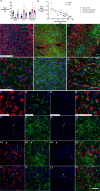Persistent cortical and white matter inflammation after therapeutic hypothermia for ischemia in near-term fetal sheep
- PMID: 35690757
- PMCID: PMC9188214
- DOI: 10.1186/s12974-022-02499-7
Persistent cortical and white matter inflammation after therapeutic hypothermia for ischemia in near-term fetal sheep
Abstract
Background: Therapeutic hypothermia significantly improves outcomes after moderate-severe hypoxic-ischemic encephalopathy (HIE), but it is partially effective. Although hypothermia is consistently associated with reduced microgliosis, it is still unclear whether it normalizes microglial morphology and phenotype.
Methods: Near-term fetal sheep (n = 24) were randomized to sham control, ischemia-normothermia, or ischemia-hypothermia. Brain sections were immunohistochemically labeled to assess neurons, microglia and their interactions with neurons, astrocytes, myelination, and gitter cells (microglia with cytoplasmic lipid granules) 7 days after cerebral ischemia. Lesions were defined as areas with complete loss of cells. RNAscope® was used to assess microglial phenotype markers CD86 and CD206.
Results: Ischemia-normothermia was associated with severe loss of neurons and myelin (p < 0.05), with extensive lesions, astrogliosis and microgliosis with a high proportion of gitter cells (p < 0.05). Microglial wrapping of neurons was present in both the ischemia groups. Hypothermia improved neuronal survival, suppressed lesions, gitter cells and gliosis (p < 0.05), and attenuated the reduction of myelin area fraction. The "M1" marker CD86 and "M2" marker CD206 were upregulated after ischemia. Hypothermia partially suppressed CD86 in the cortex only (p < 0.05), but did not affect CD206.
Conclusions: Hypothermia prevented lesions after cerebral ischemia, but only partially suppressed microglial wrapping and M1 marker expression. These data support the hypothesis that persistent upregulation of injurious microglial activity may contribute to partial neuroprotection after hypothermia, and that immunomodulation after rewarming may be an important therapeutic target.
Keywords: Electroencephalogram; Gitter cells; Hypoxia-ischemia; Microglial phenotype; Neuroinflammation; Therapeutic hypothermia.
© 2022. The Author(s).
Conflict of interest statement
The authors declare that they have no competing interests.
Figures










Similar articles
-
Slow rewarming after hypothermia does not ameliorate white matter injury after hypoxia-ischemia in near-term fetal sheep.Pediatr Res. 2025 Feb;97(3):1209-1219. doi: 10.1038/s41390-024-03332-y. Epub 2024 Aug 5. Pediatr Res. 2025. PMID: 39103629 Free PMC article.
-
Protection of axonal integrity with 48 or 72 h of cerebral hypothermia in near-term fetal sheep.Pediatr Res. 2020 Jul;88(1):48-56. doi: 10.1038/s41390-019-0475-8. Epub 2019 Jun 24. Pediatr Res. 2020. PMID: 31234193
-
Differential effects of slow rewarming after cerebral hypothermia on white matter recovery after global cerebral ischemia in near-term fetal sheep.Sci Rep. 2019 Jul 12;9(1):10142. doi: 10.1038/s41598-019-46505-0. Sci Rep. 2019. PMID: 31300687 Free PMC article.
-
Cooling and immunomodulation for treating hypoxic-ischemic brain injury.Pediatr Int. 2020 Jul;62(7):770-778. doi: 10.1111/ped.14215. Epub 2020 Jul 9. Pediatr Int. 2020. PMID: 32119180 Review.
-
Therapeutic Hypothermia in Neonatal Hypoxic-Ischemic Encephalopathy.Curr Neurol Neurosci Rep. 2019 Jan 14;19(2):2. doi: 10.1007/s11910-019-0916-0. Curr Neurol Neurosci Rep. 2019. PMID: 30637551 Review.
Cited by
-
Targeting Persistent Neuroinflammation after Hypoxic-Ischemic Encephalopathy-Is Exendin-4 the Answer?Int J Mol Sci. 2022 Sep 5;23(17):10191. doi: 10.3390/ijms231710191. Int J Mol Sci. 2022. PMID: 36077587 Free PMC article. Review.
-
Brain organoids for hypoxic-ischemic studies: from bench to bedside.Cell Mol Life Sci. 2023 Oct 7;80(11):318. doi: 10.1007/s00018-023-04951-0. Cell Mol Life Sci. 2023. PMID: 37804439 Free PMC article. Review.
-
Synergistic effect of sildenafil combined with controlled hypothermia to alleviate microglial activation after neonatal hypoxia-ischemia in rats.J Neuroinflammation. 2024 Jan 23;21(1):31. doi: 10.1186/s12974-024-03022-w. J Neuroinflammation. 2024. PMID: 38263116 Free PMC article.
-
The Temporal Relationship between Blood-Brain Barrier Integrity and Microglial Response following Neonatal Hypoxia Ischemia.Cells. 2024 Apr 9;13(8):660. doi: 10.3390/cells13080660. Cells. 2024. PMID: 38667275 Free PMC article.
-
Dysmaturation of sleep state and electroencephalographic activity after hypoxia-ischaemia in preterm fetal sheep.J Cereb Blood Flow Metab. 2024 Aug;44(8):1376-1392. doi: 10.1177/0271678X241236014. Epub 2024 Feb 28. J Cereb Blood Flow Metab. 2024. PMID: 38415649 Free PMC article.
References
-
- Jacobs S, Hunt R, Tarnow-Mordi W, Inder T, Davis P. Cooling for newborns with hypoxic ischaemic encephalopathy. Cochrane Database Syst Rev. 2003:CD003311. - PubMed
Publication types
MeSH terms
Grants and funding
LinkOut - more resources
Full Text Sources
Medical

